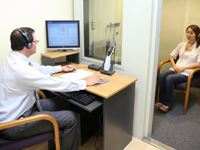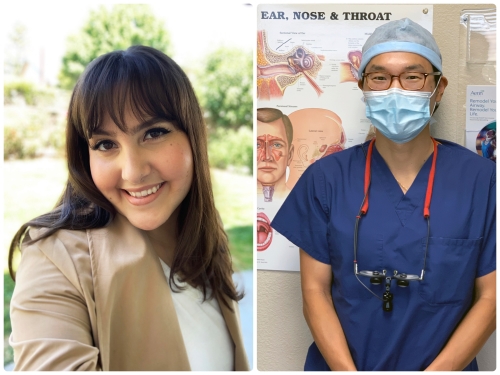
Diagnostic Procedures
Diagnostic Audiogram
 An audiogram uses sounds of specific frequencies and intensity levels to
determine what a person can hear in each ear. The sounds are heard through
headphones in a soundproof room, and the patient is asked to identify
each time they hear a sound and in which ear it is being heard. The sounds
will become lower and lower to determine the level in which a patient
can barely hear. An audiogram in our office may also include speech discrimination
in the form of two-syllable words to determine how well a patient can
comprehend what is being heard. This allows for evaluation of not only
cochlear or inner-ear function, but also central auditory or brain functioning
related to hearing. The results of this test and appropriate treatment
approaches will be discussed with your doctor.
An audiogram uses sounds of specific frequencies and intensity levels to
determine what a person can hear in each ear. The sounds are heard through
headphones in a soundproof room, and the patient is asked to identify
each time they hear a sound and in which ear it is being heard. The sounds
will become lower and lower to determine the level in which a patient
can barely hear. An audiogram in our office may also include speech discrimination
in the form of two-syllable words to determine how well a patient can
comprehend what is being heard. This allows for evaluation of not only
cochlear or inner-ear function, but also central auditory or brain functioning
related to hearing. The results of this test and appropriate treatment
approaches will be discussed with your doctor.
Tympanometry
Tympanometry is a compliance test of the ear drum that uses pressure sweeps to detect eustachian tube dysfunction, middle ear fluid or other abnormalities within the ear, as well as evaluating the overall functionality of the ear drum, or tympanic membrane. A probe is inserted into the ear, forming an airtight seal. The probe then delivers a test tone and varying pressure sweeps. The responses of the eardrum to these pressure sweeps are plotted to measure ear drum compliance.
Abnormal results may be the result of fluid in the middle ear, a perforated or scarred ear drum, impacted ear wax, eustachian tube dysfunction, a tumor, or lack of contact between the conduction bones of the middle ear.
Pediatric Audiological Testing
Visual Reinforcement Audiometry (VRA)
During VRA, the child uses earphones or sits between two speakers from which certain sounds are presented. A tone, speech or music may be played in order to encourage the child to respond by shifting their eyes or turning their head. When the child responds to the stimulus, they are rewarded with an interesting visual display, such as an animated toy. VRA performed with headphones can test each ear separately, while testing without headphones evaluates the child’s sound field instead. This test is ideal for children between the ages of seven and thirty months.
Behavioral Observation Audiometry (BOA)
BOA tests hearing by provoking a behavioral response to an acoustic stimulus. Used for infants from birth through seven months, the patient is observed for responses such as body movement, eye widening, eye opening or change in sucking rate after a stimulus is provided. This test is used to rule out hearing loss and related conditions.
Tympanometry
Tympanometry is a compliance test that examines and assesses ear drum functionality by measuring responses to varying air pressure sweeps within the ear canal. A probe is inserted into the ear to produce a test tone and different pressure levels, and then record the responses within the sealed canal. Abnormal results may be the result of fluid in the middle ear, perforated ear drum, eustachian tube dysfunction or impacted ear wax.
Otoacoustic Emissions (OAE) testing
AEs are very soft acoustic responses to stimuli from the outer hair cells in the cochlea. Damage to the inner ear causes these responses to disappear, so measurement of these responses can be used to evaluate the health of the ear. OAE testing is performed by inserting a probe containing a microphone and speaker into the ear canal to emit a sound, and then recording the response signal. The test is performed as a routine screening exam for newborns to detect any possibility of hearing loss or related conditions. Absent or very soft response signals may indicate hearing loss, fluid behind the ears or damage to the cochlea.
-
ENT/Otolaryngology ENT, Otolaryngology 2557 Mowry Ave.
Suite 30
Fremont, CA 94538
(510) 248-1590 More Information




